The Blue Ridge Mountains, a part of the Appalachian range, are a fascinating geological marvel with a rich history. Let's dive into their story, which is as intriguing as it is ancient.
The Birth of the Blue Ridge Mountains
The story of the Blue Ridge Mountains begins about 1.1 billion to 250 million years ago. Imagine the Earth back then, with its tectonic plates shifting and moving. This movement led to the uplifting of these plates, giving birth to the Blue Ridge Mountains. It's like watching a slow-motion dance of the Earth's crust, rising to form these majestic peaks.
A Journey Through Time
The Blue Ridge Mountains are some of the oldest mountains in the world. They're second only to South Africa’s Barberton greenstone belt in age. When they first emerged, they were among the highest mountains in the world. Picture this: towering peaks, possibly as high as the Alps today, dominating the landscape. However, over time, erosion has reduced their heights. Today, the highest peak in the Blue Ridge, Mount Mitchell in North Carolina, stands at 6,684 feet - still quite impressive, right?
A Range Spanning States
The Blue Ridge Mountains stretch across several states, including Pennsylvania, Maryland, Virginia, West Virginia, Tennessee, North Carolina, and Georgia. They start as a narrow ridge and widen as they go south, reaching up to 70 miles across in North Carolina. The highest point in Virginia is Mount Rogers, standing tall at 5,729 feet.
Why Are They Blue?
Ever wondered why they're called the 'Blue Ridge' Mountains? It's because of the distinctive blue haze that seems to envelop them. This blue tint comes from the forests on these mountains, which release hydrocarbons into the atmosphere, creating that mesmerizing blue hue.
A Changing Ecosystem
The ecosystem of the Blue Ridge Mountains has evolved over tens of thousands of years. Once dominated by spruce and fir trees, the warming climate has caused these cooler ecosystems to retreat to higher elevations. Today, only about 100 square miles of this unique habitat remain, almost all in the Blue Ridge.
Human History in the Blue Ridge
Humans have been part of the Blue Ridge story for possibly as long as 12,000 years. Various indigenous tribes, including the Siouxan Manhouacs, Iroquois, Shawnee, and Cherokee, have called these mountains home or used them for hunting and fishing. The mountains have witnessed everything from civil war skirmishes to foxhunting and even served as spiritual centers for some communities.
Geological Composition
The Blue Ridge Mountains are primarily composed of highly deformed metamorphic rocks. These rocks, including schists, gneisses, slates, and quartzites, formed due to the intense compressive forces during the mountain-building process. The spine of the Blue Ridge, where the tectonic plates collided, is highly metamorphosed, showcasing the immense geological forces at play.
In summary, the Blue Ridge Mountains are not just a range of peaks. They are a testament to the Earth's dynamic history, a witness to human civilization's evolution, and a living, breathing ecosystem that continues to evolve and inspire. From their ancient origins to their cultural significance, these mountains are a true natural wonder.



Share:
How Did the Appalachians Form?
Solar Eclipse Paths Explained